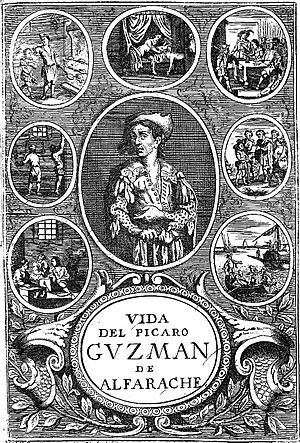Guzmán de Alfarache facts for kids

Frontispiece of an edition of both parts, published in Antwerp by Jerónimo Verdussen in 1681 and illustrated by Gaspar Bouttats.
|
|
| Author | Mateo Alemán |
|---|---|
| Original title | Guzmán de Alfarache |
| Translator | James Mabbe |
| Country | Spain and Portugal |
| Language | Spanish |
| Genre | Picaresque novel |
| Publisher | Várez de Castro, Madrid (first part); Pedro Craasbeck, Lisbon (second part) |
|
Publication date
|
1599, 1604 |
|
Published in English
|
1622 |
Guzmán de Alfarache (Spanish pronunciation: [ɡuθˈman de alfaˈɾatʃe]) is a famous picaresque novel written by Mateo Alemán. It was published in two parts. The first part came out in Madrid in 1599. The second part was released in 1604.
The story is told by Guzmán himself. He is a picaro, which means a clever, often mischievous, young person from the streets. The book follows his adventures as he grows up. It shows his journey from childhood into adulthood. The novel also teaches lessons about life and the choices people make. It was seen as a way to talk about the mistakes in society.
This book was very popular when it was first published. Many copies were printed. It was translated into several languages, including French, German, English, and Italian. The English version came out in 1622. It was translated by James Mabbe. This English version was also known as The Rogue.
Because the book was so popular, other writers made their own unofficial follow-up stories. One important one was written in 1602. It was likely by Juan Martí, who used the pen name Mateo Luján de Sayavedra. This unofficial story was very successful. It even influenced Mateo Alemán's own second part of the novel.
Contents
What is a Picaresque Novel?
This book is a great example of a picaresque novel. These stories often feature a main character who is an "antihero." This means they are not a typical brave or perfect hero. Instead, they are often flawed and make mistakes.
Guzmán is born into a difficult life. He faces many challenges and gets into trouble. He travels through different places and meets many kinds of people. His journey shows how he learns from his experiences.
Modern Versions of the Book
Even today, people still read Guzmán de Alfarache. Some important modern editions of the book include:
- Francisco Rico, Barcelona, Planeta, 1987. ISBN: 978-84-320-3886-0
- José María Micó, Madrid, Cátedra, 1987. ISBN: 978-84-376-0708-5
Film Adaptation
In 1987, a movie was made that was loosely based on the novel. It was called The Rogues. The film was directed by Mario Monicelli.
Images for kids
See also
 In Spanish: Guzmán de Alfarache para niños
In Spanish: Guzmán de Alfarache para niños


